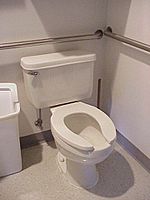Sanitation facts for kids
Sanitation is all about having safe and clean ways to deal with human waste, like pee and poop. It also means keeping things tidy by getting rid of garbage, cleaning up dirty water, and handling dangerous waste safely. Good sanitation is super important because it stops germs from spreading and helps keep people healthy.
In some countries where people are not as wealthy, they often don't have good toilets or proper sewage systems. This can make it harder to stay healthy. But in developed countries, there are usually good sewage systems that help clean the water and remove harmful stuff. Using toilets and having good sewage systems protects everyone's health by keeping germs out of our surroundings.
Contents
What is Sanitation?
Sanitation means making sure our environment is clean and safe. It covers several important things:
- Managing human waste: This means safely collecting and getting rid of pee and poop.
- Handling garbage: It's about properly throwing away and dealing with all the trash we create.
- Cleaning wastewater: This involves treating dirty water from homes and factories so it doesn't harm the environment or people.
- Dealing with dangerous waste: Some waste, like certain chemicals, can be harmful. Sanitation includes safe ways to store and get rid of these.
Why Sanitation Matters
Good sanitation is really important for everyone's health. When human waste and garbage are not handled properly, they can spread diseases very easily. Germs can get into our water, food, and even the air we breathe. This can make many people sick.
For example, if there are no proper toilets, people might have to go to the bathroom outside. This can lead to germs spreading and causing illnesses like cholera or typhoid. By having clean toilets and good systems to manage waste, we can stop these germs from spreading. This helps communities stay healthy and strong.
Toilets and Clean Water Systems
Toilets are a key part of good sanitation. They help keep germs contained and away from people. After you flush, the waste usually goes into a sewage system. This system is like a network of pipes that carries the dirty water away from homes and buildings.
The dirty water then goes to a treatment plant. At the plant, the water is cleaned to remove all the harmful things, like toxins and germs. Once it's clean, the water can be safely returned to rivers or used for other purposes. This whole process protects our environment and keeps our drinking water safe.
Images for kids
-
Sewage treatment plant, Australia.
-
Modern restaurant food preparation area.
-
Hygiene education (on proper handwashing) in Afghanistan
See also
 In Spanish: Saneamiento ambiental para niños
In Spanish: Saneamiento ambiental para niños










